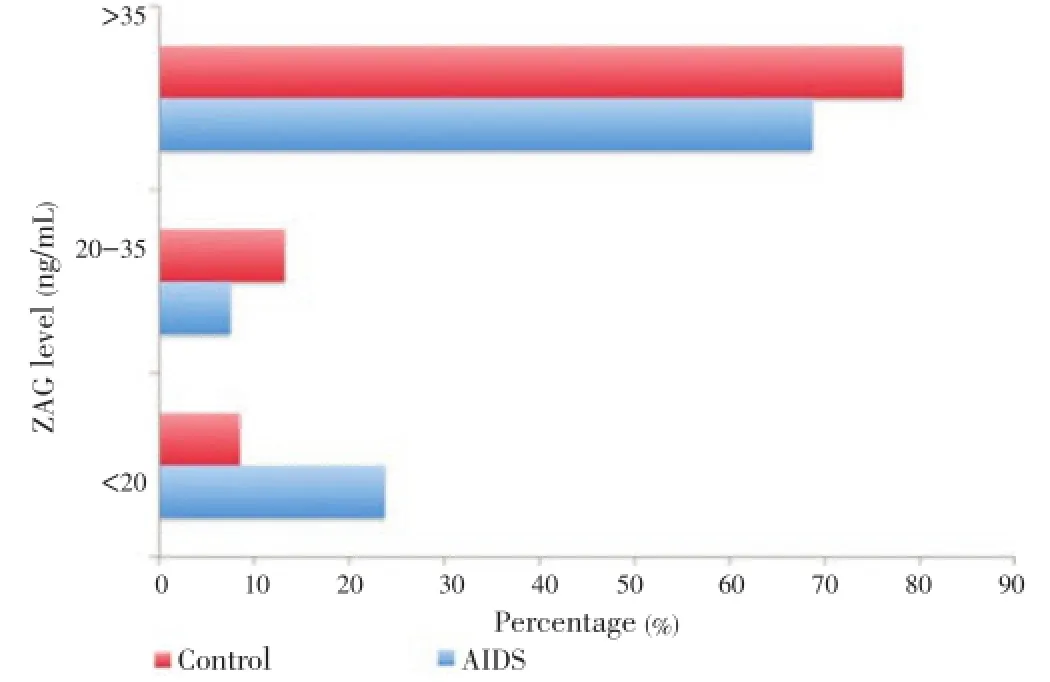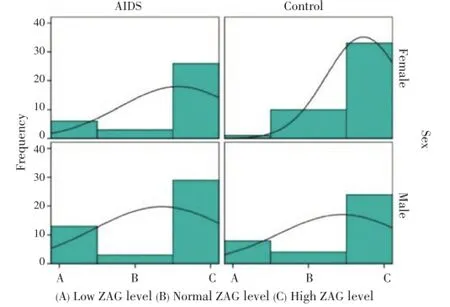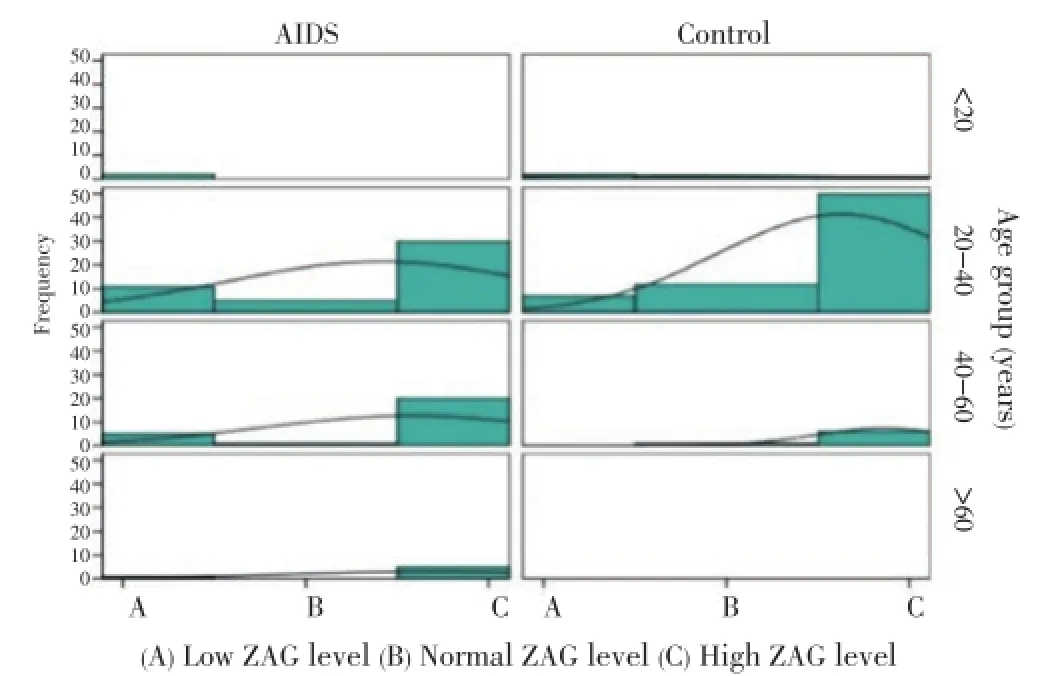High levels of Zinc-α-2-Glycoprotein among Omani AIDS patients on combined antiretroviral therapy
Sidgi Syed Anwer Hasson, Mohammed Saeed Al-Balushi, Muzna Hamed Al Yahmadi, Juma Zaid Al-Busaidi, Elias Antony Said, Mohammed Shafeeq Othman, Talal Abdullah Sallam, Mohammed Ahmad Idris, Ali Abdullah Al-Jabri
1Department of Microbiology and Immunology, College of Medicine and Health Sciences, Sultan Qaboos University, P.O. Box 35, Muscat, Oman
2Department of Community Health, Faculty of Applied Medical Sciences, Al-Baha University, Saudi Arabia
High levels of Zinc-α-2-Glycoprotein among Omani AIDS patients on combined antiretroviral therapy
Sidgi Syed Anwer Hasson1*, Mohammed Saeed Al-Balushi1, Muzna Hamed Al Yahmadi1, Juma Zaid Al-Busaidi1, Elias Antony Said1, Mohammed Shafeeq Othman1, Talal Abdullah Sallam2, Mohammed Ahmad Idris1, Ali Abdullah Al-Jabri1
1Department of Microbiology and Immunology, College of Medicine and Health Sciences, Sultan Qaboos University, P.O. Box 35, Muscat, Oman
2Department of Community Health, Faculty of Applied Medical Sciences, Al-Baha University, Saudi Arabia
PEER REVIEW
Peer reviewer
Dr. Inshrah A. AIsmaiel, Department Haematology, University of Aden, Republic of Yemen.
Tel: 009672243041
E-mail: dr.iismaiel@gmail.com
Comments
This is an adequate pilot study in which the authors have investigated the level of ZAG and its correlation with HIV/AIDS patients in parallel with health individuals. The experimental design and results were well demonstrated. It has very good scope to further continue this work with more advanced tools to prove that the measurement of ZAG level may be one of the blood transfusion necessary parameters for those who are clinically under weight.
Details on Page 613
Objective:To investigate the levels of zinc-α-2-glycoprotein (ZAG) among Omani AIDS patients receiving combined antiretroviral therapy (cART).
Zinc-α-2-glycoprotein, AIDS, Patients, Combined antiretroviral therapy, Levels, Oman
1. Introduction
Zinc-α-2-glycoprotein (ZAG) is a 40-kilodalton (kDa) single-chain polypeptide with many important functions, such as fertilization and lipid mobilization[1]. ZAG is structurally similar to major histocompatibility complex class I molecules and considered to be an adipokine[2-4]. This soluble protein has been discovered to enhance lipolysis and influence other physiological processes[5]. Furthermore, ZAG levels have been correlated with a variety of diseases, such as atherosclerosis[6], type II diabetes and a number of carcinomas[7,8]. ZAG is normally produced by the epithelial cells in several tissues, including the liver, adipose tissues, sweat glands, breasts and gastrointestinal tract[9]. It is found in various bodily fluids such as plasma, semen, sweat, milk and cerebrospinal fluid[10]. The plasma concentration of ZAG is affected by several factors, including body weight and health status.
Due to its stimulation of lipolysis, elevated ZAG levels may lead to weight loss and further complications especially for patients with acquired immunodeficiency syndrome (AIDS) [4]. Prolonged usage of combined antiretroviral therapy (cART) in AIDS patients is associated with toxicities that may limit their success. Among these toxicities is theappearance of lipodystrophy syndrome. This includes a series of body morphological changes including peripheral fat atrophy and truncal fat accumulation[11].
To the best of our knowledge, this is the first study in the region to investigate the levels of ZAG among AIDS patients.
2. Materials and methods
2.1. Participants
The sample group (n=80) comprised of 45 (56%) male patients and 35 (44%) female patients with AIDS who were receiving cART at Sultan Qaboos University Hospital (SQUH), Muscat, Oman. The age range of the patients was 18 to 70 years, with the majority (60, 75%) of them aged between 20 to 60 years (mean±SD=35.75±3.75 years). Information concerning patients’ weights was obtained using the SQU hospital’s internal information system. The control group consisted of 80 healthy blood donors, 34 (43%) females and 46 (57%) males, who were visiting the SQUH Blood Bank from various regions in Oman. The age ranges of the healthy individuals were between 18 to 55 years, with the majority (56, 70%) of them between 20 to 40 years (mean±SD=25.75±3.75 years).
This study was approved by the Medical Research Committee and the Ethics Committee of the College of Medicine & Health Sciences of Sultan Qaboos University.
2.2. Measurement ofZAGlevels
The serum analysis for determining the ZAG levels was carried out using a competitive enzyme-linked immunosorbent assay (ELISA) (Abnova GmbH Corp., Heidelberg, Germany), which utilized anti-ZAG antibodies to indirectly detect the amount of ZAG proteins in the sera samples. The assays were performed according to the manufacturer instructions.
2.3. Data analysis
The Statistical Package for Social Sciences (SPSS version 20) was used for data processing and analysis. Data were described using mean, standard deviation, median as well as the 95% confidence interval (CI) of the mean.Chisquared was used to test the significance of the associations between the ZAG levels and the variables of age and gender. The presence of a significant correlation was assessed using Spearman’s rank correlation coefficient test. Significance of the obtained results was judged at the 5% level relying on exactPvalue.
3. Results
3.1. ZAG levels in healthy individuals and AIDS patients
The distribution of ZAG levels in the serum samples of AIDS patients and the healthy individuals is demonstrated in Figure 1. A significant difference in ZAG distribution was clearly shown between the AIDS patients and the healthy people, with a 96.2% level of confidence (P=0.033).
A total of 6 (7.5%) of the AIDS patients were found to have ZAG levels within the normal range (20 to 35 ng/mL), compared with 10 (12.5%) of the healthy individuals. Nineteen (23.75%) of the AIDS patients were found to have low ZAG levels (<20 ng/mL), which is more than two times higher than the finding among the healthy people 7 (8.75%). No significant differences were detected between the AIDS patients and the healthy people with regards to the high levels of ZAG (>35 ng/ mL).

Figure 1. The distribution of ZAG level among AIDS patients and control group.Low ZAG levels: <20 ng/mL; Normal level: 20-35 ng/mL; High ZAG level: >35 ng/mL.
3.2. The relationship between patients’gender andZAGlevels
The distribution of ZAG levels among AIDS patients and the healthy people (controls) in relation to gender is displayed in Figure 2. The frequency (21%) of AIDS female patients with low ZAG levels was found to be higher than females in the healthy group. This is in contrast to findings for the normal ZAG levels and high range categories; a higher percentage of females in the healthy group were found to have normal to high ZAG levels compared with that of the AIDS female patients group. Additionally, the subgroup of AIDS male patients showed similar, results. With the exception of the high ZAG level category, the frequency of AIDS male patients, with high ZAG levels, was higher than the males in the healthy control group.

Figure 2. A histogram showing the frequency of ZAG levels by gender among Omani AIDS patients and the healthy people (control group).A histogram showing the frequency of ZAG levels by gender among Omani AIDS patients and the healthy people (control group). Line showed the median distribution for each cut off values. Low ZAG levels: <20 ng/mL; Normal level: 20-35 ng/mL; High ZAG level: >35 ng/mL.
3.3. The relationship between patients’age andZAGlevels
The distribution of ZAG levels among the AIDS patients and healthy people in relation to age is shown in Figure 3. Among the age group of 20 to 40 years, although a higher frequency (24%) of AIDS patients demonstrated low levels of ZAG in comparison to the healthy people, this finding was not significant. However, among the age group 40 to 60 years, AIDS patients showed a higher frequency compared with the healthy group, in both the low and high ZAG categories (Figure 3).

Figure 3. A histogram showing the frequency of ZAG levels by age among Omani AIDS patients and healthy individuals (Control).Low ZAG levels: <20 ng/mL; Normal level: 20-35 ng/mL; High ZAG level: >35 ng/mL.
The weight of the AIDS patients was observed over a period of one year, and it has been found that AIDS patients had high ZAG levels along with an observed decreased in weight, (data not shown). However, about 10% of the patients also had high ZAG level with increase in weight.
4. Discussion
ZAG is a novel adipokine having a major role in normal health and in chronic diseases[12]. ZAG is known to stimulate lipolysis in murine epididymal adipocytes through the stimulation of adenylate cyclase in a guanosine triphosphate (GTP)-dependent process via binding through the h3-adrenoceptor[13,14]. It is involved preferentially in the depletion of fatty acids from the adipose tissues, and accordingly named as lipid-mobilizing factor[15].
This study indicated the majority of both the AIDS patients and the healthy individuals were found to have high ZAG levels. However, relatively lower ZAG levels were found among the AIDS patients receiving cART.
An alternate conceivable relationship exists between ZAG levels and patients with AIDS who are experiencing weight reduction. Such a correlation was illustrated by Ceperuelo-Mallafréet al. in 2012, when they demonstrated that ZAG levels were lower in AIDS patients on antiviral medications than in sound uninfected individuals. The findings of this study are in agreement with those reported by Ceperuelo-Mallafréet al.that AIDS patients receiving cART showed lower ZAG levels than the control group[4].
The stimulation of lipolysis is one of the ZAG protein’s major functions. cART for patients with AIDS usually increase lipolysis by decreasing the triglyceride accumulation, lipogenesis and the articulation of the adipose markers; in addition, they also increase lipolysis by stimulating fat catabolism[16]. As per the part that ZAG proteins play in lipolysis, it might be anticipated that cART has an alternate conceivable mechanism causing lipolysis: an increment in ZAG amalgamation and secretion. This may contribute to explaining the high ZAG levels found in this study among the majority of AIDS patients receiving cART. Apart from cART, there are different possibilities to explain the high ZAG levels in the AIDS patients receiving cART. The HIV infection itself may increase ZAG levels[4]; an alternate probability is the known association between ZAG levels and cancer, as cancer is one of the common complications of AIDS[17]. In fact AIDS is known to involve inflammatory responses that may result from a combined effect of the cART, the increase of lipolytic activity and the metabolic disturbances.
The highest levels of ZAG in both AIDS patients and the healthy individuals appeared among the age group 20-40 years, which could be illustrated by its cooperation with high metabolic rates[18]. In the age group 40-60 years, the AIDS patients showed higher ZAG levels than the control group. This could be due to several factors, such as AIDS-related complications, antiviral drugs or the infection by HIV. Therefore, this study indicates the need for measurements of ZAG levels not only among AIDS patients but possibly among other patients especially prior to blood transfusions for patients who are clinically underweight.
Gender seems to play no role in the change of ZAG level. It was observed that the distribution of ZAG levels in AIDS patients is not influenced by the gender of the patient, as ZAG levels among the male and female subgroups were proportionally similar.
Previous studies have suggested that ZAG level was correlated with weight loss in healthy uninfected patients[19]. Our results however, showed that, 16 (20%) AIDS patients have high levels ZAG levels, which are significantly (P>0.031) associated with weight loss. Interestingly, 10% of the patients with high ZAG levels showed increase in their weight. High ZAG levels in these patients may precede the process of developing AIDS-related complications such as cancer. Additionally, this study showed that age might influence the plasma levels of ZAG.
ZAG levels are high among Omani AIDS patients on cART and this necessitates the measurement of ZAG levels on routine basis, as it is associated with weight loss.
Conflict of interest statement
We declare that we have no conflict of interest.
Acknowledgements
Acknowledgment is extended to AIDS patients who donated their blood kindly with their consent for this project, and Dr. Abdullah Balkhair. This study is supported by the Research Council of the Sultanate of Oman (RC/MED/MICR/11/01) and the College of Medicine and Health Sciences, Sultan Qaboos University (Internal-Grant/2013), Oman.
Comments
Background
This is a good study and the authors investigated the levels of ZAG among Omani AIDS patients receiving cART. This is a first study to correlate the stimulation of lipolysis with the level of ZAG with weight loss especially for patients with AIDS. The results demonstrated ZAG levels are high among Omani AIDS patients on cART and this necessitates the measurement of ZAG on routine basis, as it is associated with weight loss.
Research frontiers
The study was carried out to investigate the correlation of ZAG and its elevation “if any” associated with patients suffering from HIV infection. Among the different clinical complications that HIV and/or AIDS patients experience are toxicities in which this study exploited is the appearance of lipodystrophy syndrome. This includes a series of body morphological changes including peripheral fat atrophy and truncal fat accumulation.
The main cutting edge in the field of research in this paper is the first report to correlate the stimulation of lipolysis with the level of ZAG with weight loss especially for patients with AIDS.
Related reports
Authors have taken note of earlier studies of other disesese related to ZAG level [Fantuzzi G. Adipose tissue, adipokines, and inflammation (2005); Delort Let al. Zincα2-glycoprotein: a proliferative factor for breast cancer?In vitrostudy and molecular mechanisms (2013)].
Innovations and breakthroughs
This paper is an excellent pilot study from which a considerable work can be headed in the future, which may play a vital role in considering blood transfusion with those patients with clinical underweight.
Applications
The present investigation revealed that measuring the ZAG level could be one of the future parameter(s) to be considered in blood transfusion. It is important to study and investigate this further in detail to evaluate the clinical correlation of the elevated ZAG level and weight loss. Therefore, this pilot study and the consideration of any subsequent research of ZAG and weight loss may act as a future blood transfusion guideline.
Peer review
This is an adequate pilot study in which the authors have investigated the level of ZAG and its correlation with HIV/AIDS patients in parallel with health individuals. The experimental design and results were well demonstrated. It has very good scope to further continue this work with more advanced tools to prove that the measurement of ZAG level may be one of the blood transfusion necessary parameters for those who are clinically underweight.
[1] Stejskal D, Karpísek M, Reutová H, Stejskal P, Kotolová H, Kollár P. Determination of serum zinc-alpha-2-glycoprotein in patients with metabolic syndrome by a new ELISA. Clin Biochem 2008; 41: 313-316.
[2] Hassan MI, Waheed A, Yadav S, Singh TP, Ahmad F. Zinc alpha 2-glycoprotein: a multidisciplinary protein. Mol Cancer Res 2008; 6: 892-906.
[3] Hale LP, Price DT, Sanchez LM, Demark-Wahnefried W, Madden JF. Zinc alpha-2-glycoprotein is expressed by malignant prostatic epithelium and may serve as a potential serum marker for prostate cancer. Clin Cancer Res 2001; 7: 846-853.
[4] Ceperuelo-Mallafré V, Escoté X, Viladés C, Peraire J, Domingo P, Solano E, et al. Zinc alpha-2 glycoprotein is implicated in dyslipidaemia in HIV-1-infected patients treated with antiretroviral drugs. HIV Med 2012; 13: 297-303.
[5] Qu F, Ying X, Guo W, Guo Q, Chen G, Liu Y, et al. The role of Zn-alpha2 glycoprotein in sperm motility is mediated by changes in cyclic AMP. Reproduction 2007; 134(4): 569-576.
[6] Fantuzzi G. Adipose tissue, adipokines, and inflammation. J Allergy Clin Immunol 2005; 115: 911-919.
[7] Arner P. Insulin resistance in type 2 diabetes-role of the adipokines. Curr Mol Med 2005; 5: 333-339.
[8] Delort L, Perrier S, Dubois V, Billard H, Mracek T, Bing C, et al. Zinc-α2-glycoprotein: a proliferative factor for breast cancer? In vitro study and molecular mechanisms. Oncol Rep 2013; 29(5): 2025-2029.
[9] Pelletier CC, Koppe L, Croze ML, Kalbacher E, Vella RE, Guebre-Egziabher F, et al. White adipose tissue overproduces the lipid-mobilizing factor zinc α2-glycoprotein in chronic kidney disease. Kidney Int 2013; 83: 878-886.
[10] Hassan MI, Bilgrami S, Kumar V, Singh N, Yadav S, Kaur P, et al. Crystal structure of the novel complex formed between zinc alpha2-glycoprotein (ZAG) and prolactin-inducible protein (PIP) from human seminal plasma. J Mol Biol 2008; 384: 663-672.
[11] Moreno S, Miralles C, Negredo E, Domingo P, Estrada V, Gutiérrez F, et al. Disorders of body fat distribution in HIV-infected patients. AIDS Rev 2009; 11: 126-134.
[12] Sörensen-Zender I, Beneke J, Schmidt BMW, Menne Jan, Haller H, Schmitt R, et al. Zinc-alpha2-glycoprotein in patients with acute and chronic kidney disease. BMC Nephrol 2013; 14: 145.
[13] Philipp A, Kralisch S, Bachmann A, Lossner U, Kratzsch J, Blüher M, et al. Serum levels of the adipokine zinc-α2-glycoprotein are increased in chronic hemodialysis. Metabolism 2011; 60: 669-672.
[14] Tedeschi S, Pilotti E, Parenti E, Vicini V, Coghi P, Montanari A, et al. Serum adipokine zinc α2-glycoprotein and lipolysis in cachectic and noncachectic heart failure patients: relationship with neurohormonal and inflammatory biomarkers. Metabolism 2012; 61: 37-42.
[15] Choi JW, Liu H, Choi DK, Oh TS, Mukherjee R, Yun JW. Profiling of gender-specific rat plasma proteins associated with susceptibility or resistance to diet-induced obesity. J Proteomics 2012; 75: 1386-1400.
[16] Lenhard JM, Furfine ES, Jain RG, Ittoop O, Orband-Miller LA, Blanchard SG, et al. HIV protease inhibitors block adipogenesis and increase lipolysis in vitro. Antiviral Res 2000; 47: 121-129.
[17] Dubois V, Delort L, Mishellany F, Jarde T, Billard H, Lequeux C, et al. Zinc-α2-glycoprotein: a new biomarker of breast cancer? Anticancer Res 2010; 30: 2919-2926.
[18] Shock NW. Metabolism and age. J Chronic Dis 1955; 2: 687-703.
[19] Hasson SS, Al-Balushi MS, Al Shaili AS, Al-Busaidi JZ, Said EA, Idris MA, et al. Prevalence of zinc-α 2-glycoprotein binding peptide among Omani blood donors. J Clin Chem Lab 2013; 4(2): 32-38.
10.12980/APJTB.4.201414B126
*Corresponding author:Dr. Sidgi Syed Anwer Hasson, Department of Microbiology and Immunology, College of Medicine and Health Sciences, Sultan Qaboos University, P.O. Box: 35, Code: 123, Muscat, Oman.
Tel: +968 24143549
E-mail: shyahasson@squ.edu.om
Foundation Project: Supported by the Research Council of the Sultanate of Oman (RC/MED/MICR/11/01) and the College of Medicine and Health Sciences, Sultan Qaboos University (Internal-Grant/2013), Oman.
Article history:
Received 21 Jun 2014
Received in revised form 29 Jun, 2nd revised form 8 Jul, 3rd revised form 12 Jul 2014
Accepted 20 Jul 2014
Available online 28 Aug 2014
Methods:A total of 80 Omani AIDS patients (45 males and 35 females), average age of 36 years, who were receiving cART at the Sultan Qaboos University Hospital (SQUH), Muscat, Oman, were tested for the levels of ZAG. In addition, 80 healthy blood donors (46 males and 34 females), average age of 26 years, attending the SQUH Blood Bank, were tested in parallel as a control group. Measurement of the ZAG levels was performed using a competitive enzyme-linked immunosorbent assay and in accordance with the manufacturer’s instructions.
Results:The ZAG levels were found to be significantly higher among AIDS patients compared to the healthy individuals (P=0.033). A total of 56 (70%) of the AIDS patients were found to have higher levels of ZAG and 16 (20%) AIDS patients were found to have high ZAG levels, which are significantly (P>0.031) associated with weight loss.
Conclusions:ZAG levels are high among Omani AIDS patients on cART and this necessitates the measurement of ZAG on routine basis, as it is associated with weight loss.
 Asian Pacific Journal of Tropical Biomedicine2014年8期
Asian Pacific Journal of Tropical Biomedicine2014年8期
- Asian Pacific Journal of Tropical Biomedicine的其它文章
- An overview of travel-associated central nervous system infectious diseases: risk assessment, general considerations and future directions
- Genetic diversity of the msp-1, msp-2, and glurp genes of Plasmodium falciparum isolates along the Thai-Myanmar borders
- Impact of antibacterial drugs on human serum paraoxonase-1 (hPON1) activity: an in vitro study
- Toxicity effects of water extracts of Holothuria atra Jaeger in mice
- Prevention of renal dysfunction by nutraceuticals prepared from oil rich plant foods
- Polyketide and benzopyran compounds of an endophytic fungus isolated from Cinnamomum mollissimum: biological activity and structure
